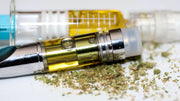
In regard to cannabinoids-for both medicinal and recreational purposes-smoking and ingesting edibles are probably the most popular methods. While both ways introduce THC and CBD cannabinoids into the body, they do so in very different ways that result in very different experiences regarding onset, intensity, and duration of effects. We'll break down the science of how cannabinoids absorb through smoking versus edibles in this article, and what you can expect from each method.
The Process of Smoking Cannabinoids
Smoking cannabis involves the actual inhalation of cannabinoid vapor, which, in turn, is absorbed through the lungs. This is actually one of the faster ways to experience cannabinoids, due to the direct route to the bloodstream via the lungs.
How It Works:
Inhalation: You smoke cannabis by inhaling vapor containing cannabinoids such as THC or CBD.
Absorption Through the Lung: The cannabinoids in the smoke pass through the membranes of the lungs, thus passing almost immediately into the bloodstream.
Rapid Onset of Effects: Because delivery is directly into the blood supply, you might feel effects in a minute or so. Maximum usually comes in around 30 minutes and then lasts for 2-3 hours.
Key Benefits:
Fast-acting Effects: It is suitable for those who seek immediate relief from some pains, anxiety, or any symptom. Control Due to the fast-acting effect, users are in a better position to control their dose by adjusting the amount smoked or vaporized at once. Disadvantages Health Risks: Cannabis smoking can cause irritation to the lungs and possibly pose a long-term threat to respiratory health.
Short Duration: While the onset is fast, it remains for a relatively shorter period in smoking than in edibles.
The Process of Edibles Ingestion
Edibles, in turn, take a much circuitous route around the body. When you consume a cannabis product for example, cannabinoids must pass through the system of digestion before they are allowed to enter into the bloodstream.
How It Works:
Ingestion: when an edible is ingested it travels down the stomach and then gets absorbed into the blood supply through the walls of the intestines.
Liver Metabolism: The cannabinoids undergo an extensive series of metabolic processes within the liver prior to reaching the bloodstream, after which it gets transformed into an even more potent, psychoactive metabolite called 11-hydroxy-THC. That takes some time-digestion and liver metabolism take about 30 minutes to 2 hours-before you can actually begin feeling any effects. But when they kick in, you can pretty much count on them lasting much longer, up to 8 hours or more. Key Benefits:
Longer-Lasting Effects: Long-lasting effects of the edibles make them suitable for any person who is looking to get long-term relief.
Stronger Psychoactive Effect: Liver conversion of THC into 11-hydroxy-THC often makes a more intense high in contrast to smoking.
Cons:
Delayed Onset: Generally, the slow onset can make dosing tricky. Some users may take too much because they don't feel the effects immediately.
Less Control: Once a food product has been ingested, you cannot "take back" an edible, and you'll have to wait for it to pass through your system.
Bioavailability: How Much Cannabinoid Your Body Absorbs
Another difference generally speaking between smoking and ingesting cannabinoids pertains to bioavailability-that is, the amount of the substance that actually enters the bloodstream and has an effect. The method of smoking offers higher bioavailability, with estimates generally believing that some 20-30% of the cannabinoids are absorbed into the bloodstream. In contrast, edibles have much lower bioavailability, with only 4-20% making it into circulation after passing through the digestive system and liver.
How Cannabinoid Metabolism Affects the Experience
The method in which cannabinoids are metabolized heavily contributes to the way in which their effects become apparent. This means that with smoking and vaping, neither involves direct metabolism in the liver; the cannabinoid will skip processing there and go directly into the bloodstream. Put simply, this just really means that the THC ends up being in its active form in your brain rather quickly, so the high could be more immediate and controllable.
Edibles, however, have to be processed through the liver, which converts THC into the even more potent 11-hydroxy-THC. It takes longer to reach the brain but results in a more powerful and longer-lasting high-at times overwhelming-if the user is inexperienced.
Which Method is Right for You?
The key factors between smoking and edibles would be based on personal preference, desired effects, and how fast one needs relief. Smokers may enjoy the immediacy and control that inhalation gives them, while edible enthusiasts may find the convenience and long-lasting effects of eating their cannabinoids to be admirable.






